"Cherishing Little Steps - A Haven for Baby and Family Journeys"
Newborn Car Seat Safety
Are you a new parent, eager to ensure the safety of your precious newborn? Taking care of your little one starts right from the moment you bring them home, and that includes ensuring their safety during car rides.
Just like a guardian angel, a properly installed car seat acts as a protective shield for your baby, keeping them safe and secure while you’re on the move.
In this guide, we will explore the world of newborn car seat safety, sharing essential tips and information to help you navigate the often overwhelming world of car seats.
From types of car seats to installation techniques, we’ve got you covered. So, let’s dive in and make sure your little one is always safeguarded on the road!
Key Takeaways
- Properly installing and using a car seat is crucial for newborn safety during car rides.
- Select a car seat appropriate for the newborn’s size, weight, and age.
- Rear-facing position offers the best protection in a crash.
- Easy installation and secure fit in the vehicle are important factors.
Importance of Newborn Car Seat Safety
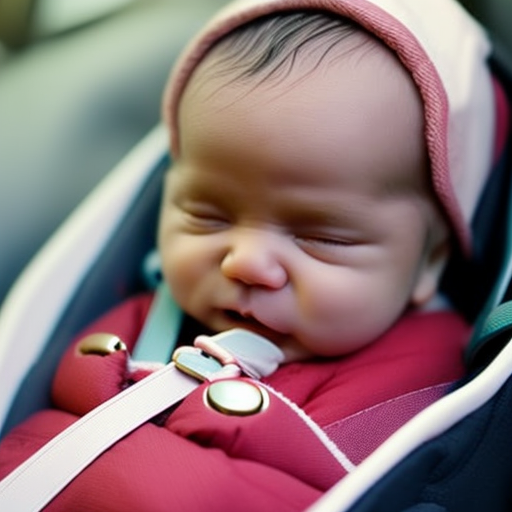
Ensure your newborn’s safety by properly installing and using their car seat. Following newborn car seat regulations is crucial to protect your little one during car rides. Understanding the importance of newborn car seat safety can help you avoid common car seat mistakes that could put your child at risk.
Newborn car seat regulations outline specific guidelines for choosing and using a car seat for your baby. It’s essential to select a car seat that’s appropriate for your newborn’s size, weight, and age. Make sure to read the manufacturer’s instructions carefully and install the car seat correctly in your vehicle. Incorrect installation can compromise the seat’s effectiveness in protecting your baby in the event of a collision.
Common car seat mistakes include using an expired or second-hand car seat, not securing the harness properly, and placing the car seat in the wrong position in the car. It’s crucial to regularly check the expiration date of your car seat and replace it if necessary. Always tighten the harness snugly around your baby, ensuring that the straps lie flat and are properly positioned on their shoulders. Additionally, place the car seat in the backseat, facing the rear, as recommended by safety experts.
Types of Car Seats for Newborns
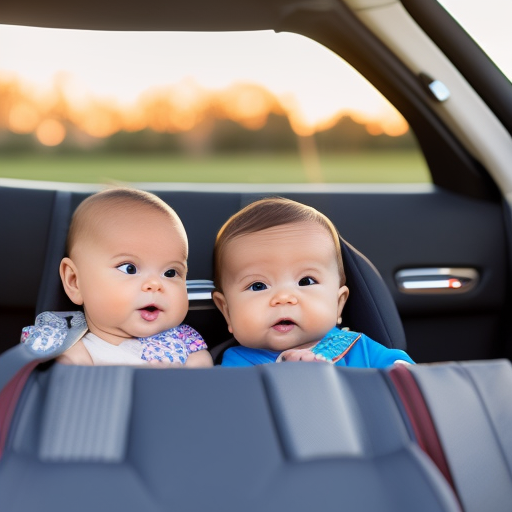
To choose the right car seat for your newborn, consider the different types available based on their age, weight, and size. There are three main types of car seats for newborns: rear-facing only, convertible, and all-in-one.
Rear-facing only car seats are designed specifically for infants and can be used from birth until your baby reaches the maximum weight or height limit specified by the manufacturer. These seats provide excellent protection for your newborn’s head, neck, and spine.
Convertible car seats can be used in both rear-facing and forward-facing positions. They’re suitable for newborns and can accommodate your child as they grow. It’s important to note that you should keep your baby in the rear-facing position for as long as possible, as it offers the best protection in the event of a crash.
All-in-one car seats are the most versatile option. They can be used in three different modes: rear-facing, forward-facing, and as a booster seat. These seats can accommodate your child from infancy through their toddler and preschool years.
When choosing a car seat for your newborn, make sure it meets the safety standards and regulations of your country. Remember, the most important thing is to ensure your baby’s safety while traveling in a vehicle.
Choosing the Right Car Seat for Your Newborn
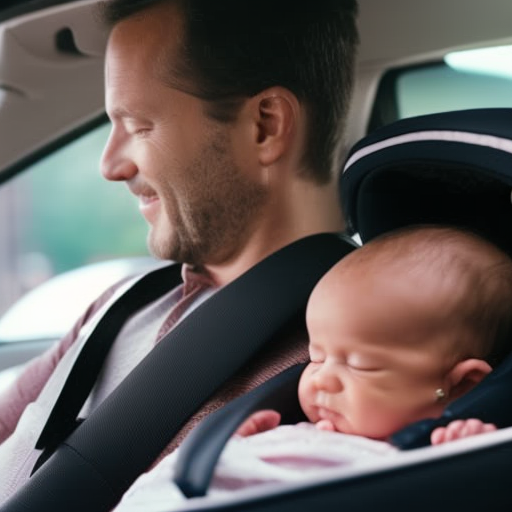
To choose the right car seat for your newborn, consider their age, weight, and size, as well as the different types available. Newborn car seats are specifically designed to keep your little one safe and comfortable during car rides. When looking for a car seat, make sure to check the weight limits specified by the manufacturer. Most newborn car seats have weight limits ranging from 4 to 35 pounds. It’s important to choose a car seat that can accommodate your baby’s weight to ensure proper protection.
In addition to weight limits, consider the features that the car seat offers. Look for features such as a five-point harness system, side-impact protection, and easy installation. The five-point harness system provides the best protection by securing your baby at the shoulders, hips, and between the legs. Side-impact protection is crucial in the event of a collision, as it helps absorb the force and protects your baby’s head and neck.
When it comes to installation, look for a car seat that’s easy to install and fits securely in your vehicle. Many car seats now come with a base that stays in the car, allowing for quick and easy installation of the seat itself.
Understanding Car Seat Safety Standards

When choosing a car seat for your newborn, it’s important to understand the specific safety standards that apply. Understanding car seat regulations is crucial in ensuring the well-being of your baby during car rides.
Car seat safety standards are set by regulatory bodies to ensure that car seats meet certain criteria for protection and effectiveness. Proper car seat installation is another critical aspect of car seat safety. Car seat regulations also include guidelines for installing car seats correctly. It’s essential to follow these instructions meticulously to ensure that the seat is securely fastened and properly positioned. Incorrect installation can compromise the effectiveness of the car seat and put your baby at risk in the event of an accident.
Car seat regulations dictate the minimum requirements for car seat design and performance. These regulations cover aspects such as the strength of the seat’s structure, the durability of the harness, and the effectiveness of the restraint system. By adhering to these standards, car seat manufacturers ensure that their products provide the necessary protection for your newborn.
Proper Installation of a Newborn Car Seat
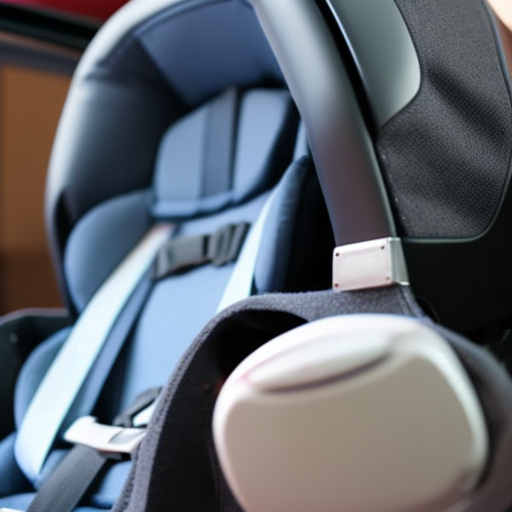
Ensure the safety of your newborn by properly installing their car seat. Proper installation techniques are crucial to ensure that your baby is secure and protected while traveling in a vehicle. Here are some important steps to follow when installing a newborn car seat.
First, read the car seat’s instruction manual thoroughly. Each car seat model may have specific installation instructions, so it’s important to familiarize yourself with them.
Next, make sure you’re using the correct installation method for your car seat. There are two common methods: using the vehicle’s seat belt or using the LATCH system (Lower Anchors and Tethers for Children).
When installing with the seat belt, ensure that it’s tightly secured through the correct belt path on the car seat. Give it a firm tug to ensure there’s no slack.
If you’re using the LATCH system, attach the lower anchors to the designated anchor points in your vehicle and tighten them securely.
Avoid these common mistakes when installing a newborn car seat. Firstly, make sure the car seat isn’t reclined too much or too upright. It should be at a 45-degree angle to provide optimal support for your baby’s developing neck and spine.
Additionally, ensure that the harness straps are properly positioned and tightened. They should be snug, but not too tight, allowing you to slide one finger between the strap and your baby’s collarbone.
Adjusting the Harness for Maximum Safety
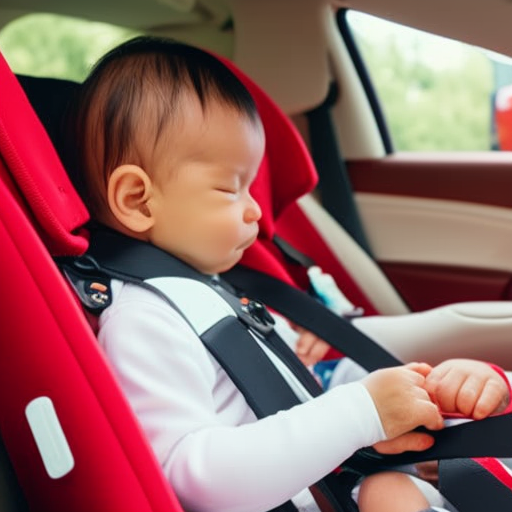
Secure your newborn’s safety by properly adjusting the harness in their car seat. Ensuring that the straps are snug and secure is crucial to their protection during car rides. Here are some important steps to follow when adjusting the harness:
-
Position the straps correctly: Start by making sure the harness straps are at or below your baby’s shoulders. This will help prevent them from sliding out in the event of sudden braking or a collision.
-
Check the tightness: The harness should be snug enough that you can only fit one finger between your baby’s collarbone and the strap. Avoid having any slack in the straps, as this can lead to increased risk of injury.
-
Secure the chest clip: The chest clip should be positioned at armpit level, resting on your baby’s chest. This clip helps keep the straps in place and ensures that the harness is properly secured.
Remember, adjusting the straps is just one part of ensuring your newborn’s safety in their car seat. It’s equally important to secure the base of the car seat properly. Make sure to follow the manufacturer’s instructions for installing the car seat base and double-check that it’s securely fastened.
Tips for Buckling Your Newborn Safely

Buckle your newborn snugly into their car seat for optimal safety. Newborn car seat installation is crucial to ensuring proper car seat fit. Here are some tips to help you buckle your newborn safely.
First, make sure the car seat is installed correctly in your vehicle. Read the car seat manual and follow the manufacturer’s instructions. It’s important to have the seat at the correct angle, with the harness straps positioned at the right height for your newborn.
Next, adjust the harness straps to fit your newborn snugly. The straps should be positioned at or below your baby’s shoulders. Use the harness slots that are closest to your baby’s body for a secure fit. Check that the straps aren’t twisted and pull them snugly so that you can only fit one finger between the strap and your baby’s collarbone.
Ensure that the chest clip is positioned correctly. It should be level with your baby’s armpits, resting on their chest. This clip helps keep the harness straps in place and prevents your baby from sliding out of the seat.
Remember, the harness should always be snug, but not too tight. You shouldn’t be able to pinch any excess strap material at your baby’s shoulders.
Avoiding Common Car Seat Installation Mistakes

To properly install your newborn’s car seat and avoid common mistakes, it’s essential to follow these guidelines:
-
Ensure a secure installation: One of the most common car seat mistakes isn’t installing it tightly enough. Make sure the seat is snugly secured to prevent any movement during travel. You can use your body weight to press down on the car seat while tightening the straps.
-
Position the car seat correctly: Another common mistake is placing the car seat in the wrong position. For rear-facing seats, the base should be reclined at the appropriate angle to support your newborn’s head and neck. Use the car seat’s level indicator to ensure proper positioning.
-
Utilize the LATCH system: Many car seats come with the LATCH (Lower Anchors and Tethers for Children) system, which provides an additional layer of stability. Ensure that the LATCH connectors are properly attached to the designated anchors in your vehicle.
Safety Checks Before Each Car Ride

Before each car ride, make sure to perform safety checks on your newborn’s car seat. These checks are crucial to ensure your baby’s safety while on the road.
Start by conducting a thorough safety inspection of the car seat. Check for any signs of wear and tear, such as frayed straps or loose buckles. Ensure that all the parts are intact and properly functioning.
Next, refer to the car seat guidelines provided by the manufacturer. These guidelines outline the correct installation and usage of the car seat. Pay close attention to weight and height limits, as well as the proper positioning of the harness straps. Adjust the harness straps to fit snugly around your baby’s shoulders, with no slack.
It’s also important to check the recline angle of the car seat. Newborns should be positioned at a semi-reclined angle to support their developing neck muscles.
Finally, make sure the car seat is securely installed in your vehicle. Give it a firm tug to ensure it doesn’t move more than an inch in any direction.
Traveling With a Newborn: Dos and Don’ts
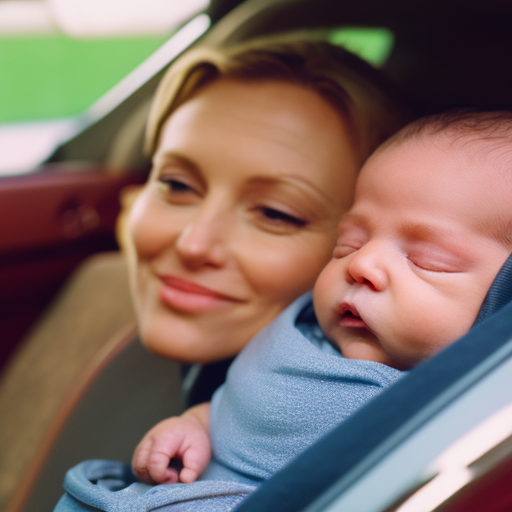
When traveling with your newborn, it’s important to adhere to certain dos and don’ts to ensure their safety. Here are some essential tips to make your car rides with your little one more calm and enjoyable:
-
Packing Essentials:
-
Keep the diaper bag fully stocked with diapers, wipes, extra clothes, and blankets.
-
Bring along a portable changing pad and a small trash bag for easy diaper changes on the go.
-
Don’t forget to pack enough formula or breast milk if you’re bottle-feeding.
-
Tips for Keeping a Newborn Calm During Car Rides:
-
Install a mirror on the backseat so you can easily see your baby’s face and reassure them when needed.
-
Play soothing music or lullabies to create a calming atmosphere.
-
Use a pacifier or bottle during the ride to help soothe your baby and keep their ears from popping.
-
Dos and Don’ts:
-
Do ensure your baby is securely strapped into their car seat, with the straps snug but not too tight.
-
Don’t place any loose objects or toys in the car seat that could become projectiles in case of sudden braking or a collision.
-
Do take frequent breaks during long drives to feed, change, and comfort your little one.
Transitioning From Infant Car Seat to Convertible Car Seat
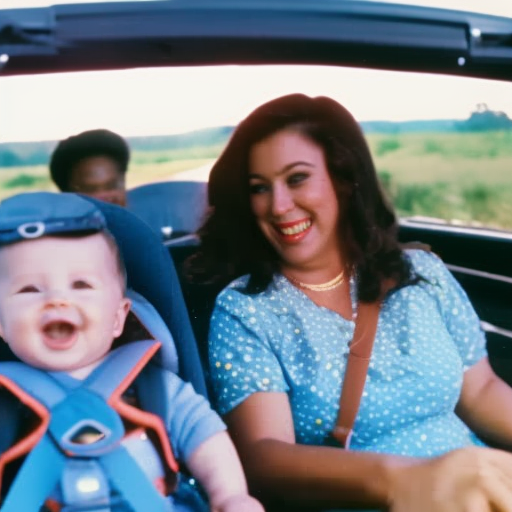
Once your baby has outgrown their infant car seat, it’s time to make the transition to a convertible car seat. This is an important step in ensuring your child’s safety while traveling.
A convertible car seat is designed to accommodate your growing child and can be used in both rear-facing and forward-facing positions.
When transitioning to a convertible car seat, it’s essential to follow the manufacturer’s guidelines and recommendations. Make sure that the seat is properly installed in your vehicle and that your child is secured snugly in the harness. It’s also important to adjust the seat’s recline angle to match your child’s age and weight.
Rear-facing is the safest position for children, and most convertible car seats allow for extended rear-facing use. It’s recommended to keep your child rear-facing for as long as possible, ideally until they reach the maximum weight or height limit of the seat.
As your child grows, you can transition to the forward-facing position. Make sure to adjust the harness straps to the appropriate height and tighten them properly to ensure a secure fit. It’s important to follow the manufacturer’s guidelines for weight and height limits when making this transition.
Frequently Asked Questions About Newborn Car Seat Safety
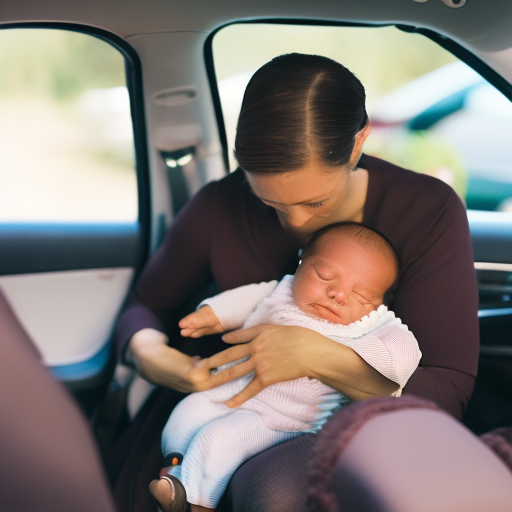
If you have questions about newborn car seat safety, you may be wondering how to ensure your baby’s well-being while traveling. Here are some frequently asked questions about newborn car seat safety to help put your mind at ease:
-
What are the newborn car seat regulations?
Newborn car seat regulations vary by country and state, but generally, they require that newborns be placed in a rear-facing car seat until they reach a certain weight or height. It’s important to check the specific regulations in your area to ensure compliance. -
What are some common car seat mistakes to avoid?
One common mistake isn’t properly installing the car seat. Make sure to read the car seat manual and follow the installation instructions carefully. Another mistake is using an expired or damaged car seat. Check the expiration date and inspect the car seat for any signs of damage. Additionally, it’s important to avoid using aftermarket accessories or modifications that aren’t approved by the car seat manufacturer. -
When should I transition my baby to a convertible car seat?
The American Academy of Pediatrics recommends keeping your child in a rear-facing car seat until they reach the maximum weight or height limit set by the car seat manufacturer. It’s generally safest to keep your child rear-facing for as long as possible.
Frequently Asked Questions
Are All Car Seats Suitable for Newborns?
Not all car seats are suitable for newborns. When it comes to car seat installation and following car seat safety guidelines, it’s important to choose one specifically designed for newborns to ensure their safety and protection.
How Long Can a Newborn Stay in a Car Seat?
When it comes to newborn car seat safety, it’s important to know how long your baby can stay in the seat. Remember to follow safe installation techniques, avoid breastfeeding while in the car seat, and consider guidelines for premature babies and long road trips.
Can I Use a Second-Hand Car Seat for My Newborn?
Yes, you can use a second-hand car seat for your newborn, but it is recommended to buy a new one for safety reasons. Following car seat safety guidelines is crucial to protect your baby.
What Should I Do if My Newborn Dislikes Being in the Car Seat?
If your newborn dislikes the car seat, try using newborn car seat accessories like head supports or strap covers. You can also try soothing techniques like playing calming music or giving them a pacifier.
When Is It Safe to Stop Using a Rear-Facing Car Seat for My Newborn?
When can you switch to a forward facing car seat for your newborn? It is safest to keep your baby in a rear-facing car seat until they reach the maximum weight or height limit recommended by the manufacturer. The benefits of using a rear-facing car seat include better protection for your baby’s head, neck, and spine.
Conclusion
Congratulations on taking the necessary steps to ensure your newborn’s car seat safety!
By choosing the right car seat, understanding safety standards, and properly installing it, you’re providing your little one with the protection they need.
Remember to always perform safety checks before each ride and follow the dos and don’ts of traveling with a newborn.
As you transition to a convertible car seat, continue to prioritize your baby’s safety.
Keep them secure on every journey, because their safety is priceless.



yandanxvurulmus.o8fgoWVn1SYH
xyandanxvurulmus.AXf9ABQwBvGa
spoonhook xyandanxvurulmus.qBuOuYCFLBY2
what is allergy medicine called best allergy medicine for rash types of allergy pills
sleeping pills by price meloset without prescription
fast acting heartburn medication order pepcid 40mg online cheap
order accutane 40mg pills order absorica pills order isotretinoin 10mg without prescription
am siteleri vurgunyedim.5ytRRTeUzETc
anal siteleri yaralandinmieycan.gDJZhDvERSDC
amoxicillin online buy buy amoxil generic buy amoxil 1000mg pills
super strong sleeping pills order provigil generic
buy azithromycin online cheap buy generic zithromax for sale azithromycin over the counter
bahis siteleri incest category citixx.clyiwdd9ihoU
escort hyuqgzhqt.wz9pEZNrYuHc
sexax ewrjghsdfaa.Wazitz2hCkla
house porn wrtgdfgdfgdqq.KIUgbyLDnV9P
bahis siteleri incest category wrtgdfgdfgdqq.rtbqO37RS7Tw
buy neurontin 100mg for sale buy gabapentin 600mg online
azithromycin 500mg for sale order azipro 250mg sale azithromycin 500mg pill
oral furosemide 100mg buy lasix for sale diuretic
generic prednisolone 10mg buy prednisolone 5mg pills omnacortil tablets
order amoxicillin buy amoxicillin sale amoxil pill
buy ventolin sale albuterol inhalator brand order generic albuterol
Porno keyfini Evooli ile daha iyi çıkartıp hazzı doruklarda yaşamaya hazırsan, hadi durma HD Porno Filmlerini ücretsiz izle.
clavulanate drug buy generic augmentin
sohbet net porn comics, 4k porn sohbet.net, chat porn sites sohbet, indian porn sohbet odalari, girls do porn http://www.sohbet.net
synthroid 75mcg brand levothyroxine without prescription purchase synthroid without prescription
vardenafil 10mg pill order vardenafil for sale
clomid 50mg pills cost clomid clomiphene 50mg oral
where to buy zanaflex without a prescription zanaflex where to buy tizanidine 2mg ca
order semaglutide 14 mg generic order semaglutide 14mg generic semaglutide 14 mg cost
buy deltasone 5mg pill prednisone us deltasone 20mg without prescription
buy generic isotretinoin purchase accutane online cheap buy generic accutane
buy semaglutide medication order rybelsus without prescription order rybelsus 14mg pills
escort siteleri hepxhupx.OeMdR6rNDCl9
escort juljulfbi.OzWaOjcYVvG4
buy generic albuterol online order albuterol 4mg pill albuterol canada
amoxil 500mg us order amoxicillin online cheap buy generic amoxil over the counter
sexax bjluajszz.PRv6QpcgzKaR
porno bxjluajsxzz.vkF7UazIbyPZ
seksi siteler 0qbxjluaxcxjsxzz.TIVcAjy08TjA
augmentin 625mg sale buy augmentin generic buy augmentin for sale
order generic azithromycin 500mg zithromax 250mg ca purchase azithromycin for sale
synthroid over the counter generic synthroid 150mcg buy synthroid 75mcg generic
buy prednisolone 5mg buy generic omnacortil 5mg omnacortil 20mg us
order neurontin 600mg sale purchase neurontin for sale neurontin ca
lasix 40mg sale furosemide 40mg usa order furosemide for sale
sildenafil 50mg for sale cheap viagra pills oral sildenafil 50mg
cheap doxycycline 100mg monodox brand doxycycline 100mg us
semaglutide online buy cheap generic rybelsus buy semaglutide without a prescription
play online casino real money play poker online for real money play great poker online
vardenafil without prescription buy vardenafil 10mg generic order vardenafil online
pregabalin medication purchase pregabalin without prescription buy pregabalin
plaquenil 400mg cheap hydroxychloroquine 400mg canada order hydroxychloroquine 400mg
triamcinolone 10mg without prescription triamcinolone online order buy triamcinolone no prescription
brand desloratadine cost clarinex generic desloratadine
Online bahis dünyası sürekli olarak gelişmekte ve bahis severler için yeni fırsatlar sunmaktadır.
cenforce without prescription cenforce 50mg drug buy cheap generic cenforce
loratadine 10mg pill buy claritin generic claritin 10mg
kiz kardesini sikiyim rplanetshop.com/
how to buy chloroquine buy chloroquine 250mg generic buy chloroquine 250mg online
bahis siteleri sikis pokkerx.AEh2DvFOBcHS
fuck google mobileidn.5agqr5XATwv9
escort siteleri 250tldenemebonusuxx.rCusmMVm8quW
porn eyeconartxx.V9yGVbLshXUp
glycomet online metformin 500mg cheap glucophage 500mg for sale
purchase xenical pills order diltiazem sale order diltiazem 180mg online cheap
watch porn video vvsetohimalxxvc.QM38Yuko21xj
norvasc 10mg over the counter amlodipine 10mg drug buy amlodipine without prescription
cost zovirax buy zovirax generic order zyloprim online cheap
lisinopril 5mg usa where to buy lisinopril without a prescription buy lisinopril 2.5mg generic
cheap crestor 10mg purchase zetia online cheap purchase zetia for sale
buy cheap generic prilosec order prilosec 20mg pill buy omeprazole 20mg sale
order motilium generic motilium 10mg pills order tetracycline 250mg sale
lopressor 100mg ca lopressor online buy generic metoprolol
order toradol 10mg pills colchicine buy online cost colchicine 0.5mg
buy tenormin 50mg pill how to get atenolol without a prescription atenolol 100mg without prescription
home porn hd gghkyogg.5tzZwmuFSfJ
porn hd 4k video download ggjennifegg.2G66kSSMUK2
http://www.hd por ggjinnysflogg.TL6q8BTxGe9
fashionflag http://www.hd porne.com fashionflag.dfHk3FMyL0p
बड़का गधा पोर्न के बा hjkvbasdfzxzz.3JA1rUXsyu4
कट्टर अश्लीलता txechdyzxca.9vmvRWSzYio
रूसी अश्लील साहित्य hkyonet.ngh9hMGKoZS
ਵੱਡੇ ਕੁੱਕੜ ਪੋਰਨ madisonivysex.9lQQKPlAiE5
ladesbet ਅਸੀਂ ਅਸ਼ਲੀਲ ਹਾਂ ladesinemi.l1Yolh6cbSr
ladesbet おもちゃのポルノ ladestinemi.OJyNWrPYF3i
geinoutime.com
Hongzhi 황제는 Xiao Jing이 들고 있던 작은 상자에 시선을 집중했습니다.